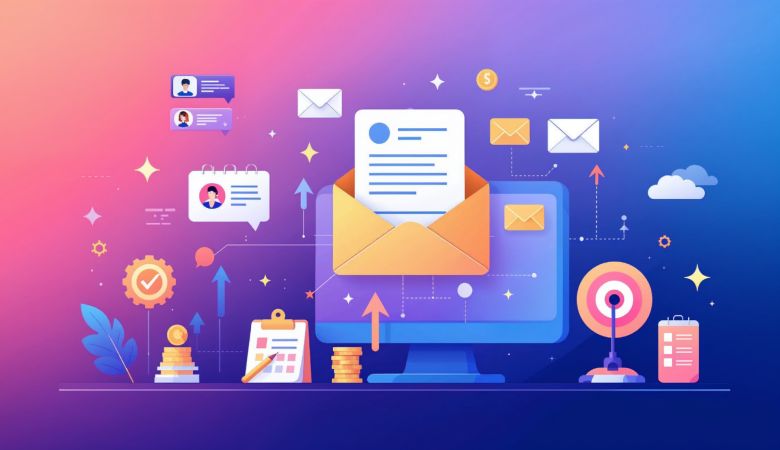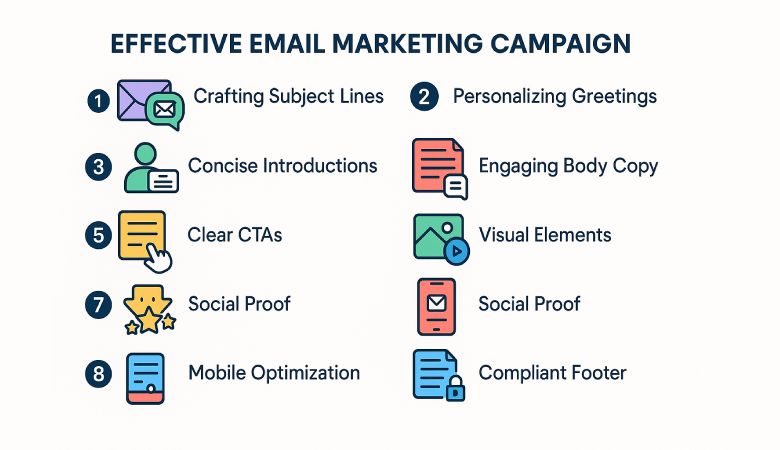A Practical Guide to Email Marketing for Business Growth
Email marketing is a powerful tool for businesses to engage audiences, nurture leads, and drive revenue. With an average ROI of $42 for every $1 spent, it’s a cost-effective channel for startups, e-commerce brands, and enterprises. This guide provides actionable strategies to boost email conversion rates, inspire email campaign content ideas, leverage email subject line personalization, and implement email marketing conversion strategies. Designed for busy business owners, it offers concise, practical advice to create high-impact email campaigns aligned with Google’s guidelines for user-focused content.
Why Email Marketing Works
Email marketing delivers direct, scalable communication with a high return on investment. Its ability to personalize messages and provide data-driven insights makes it ideal for businesses aiming to grow online. Key benefits include:
- Personalized Engagement: Tailor content to individual preferences.
- Cost-Effectiveness: Achieve significant results with minimal spend.
- Measurable Results: Track performance to optimize campaigns.
This guide focuses on practical steps to maximize these benefits, ensuring your campaigns drive measurable growth.
Building Effective Email Campaigns
Crafting compelling emails requires a strategic approach. Below are the essential components, distilled for immediate application.
1. Crafting Compelling Subject Lines
The subject line determines whether your email gets opened. A strong subject line is concise, relevant, and engaging.
Tips for Success
- Personalize: Use names or preferences (e.g., “Sarah, Your Offer Awaits!”) to increase opens by up to 20%. Email subject line personalization is critical for engagement.
- Create Urgency: Phrases like “Today Only” spark curiosity without misleading.
- Keep It Short: Aim for under 60 characters to ensure mobile compatibility.
- Test Variations: A/B test subject lines to find top performers.
Example: “Lisa, Save 25% on Your Next Order—Today Only!”
2. Personalizing Greetings
A personalized greeting fosters a connection, making recipients more likely to engage.
Best Practices
- Insert first names using merge tags (e.g., “Hi Alex”).
- Reference past actions (e.g., “Thanks for your recent purchase!”).
- Segment lists by behavior or interests for relevance.
Example: “Hi Emma, Here’s Your Exclusive Webinar Recap.”
3. Writing Concise Introductions
The introduction should hook readers by clearly stating the email’s value.
How to Do It
- Focus on benefits (e.g., “Grow sales with our new tool”).
- Keep it to 2–3 sentences.
- Preview the email’s content.
Example: “Want to increase conversions? Our latest feature can help. Here’s how.”
4. Creating Engaging Body Copy
The body delivers your message and drives action. It should be scannable and benefit-focused.
Tips for Impact
- Use a conversational tone with “you” and “your.”
- Emphasize outcomes (e.g., “Save time” vs. “Includes automation”).
- Use bullet points for readability:
- Automate tasks to save hours.
- Boost sales with targeted offers.
- Track results in real time.
- Include a brief success story (e.g., “Client X saw 20% more clicks”).
5. Designing Clear Calls-to-Action (CTAs)
A strong CTA guides recipients to act, such as purchasing or signing up.
Best Practices
- Use action verbs (e.g., “Shop Now,” “Start Free Trial”).
- Design buttons with bold colors.
- Limit to one primary CTA.
- Add urgency (e.g., “Claim Offer Before It Expires”).
Example: A green “Get Started” button stands out and drives clicks.
6. Using Visual Elements
Visuals enhance engagement but must be purposeful and optimized.
Guidelines
- Use relevant images (e.g., product photos).
- Compress files for fast loading.
- Add descriptive alt text for accessibility.
- Avoid overloading with visuals.
Visual Aid Suggestion: Include an infographic summarizing the email creation process (e.g., subject line → greeting → CTA).
7. Adding Social Proof
Social proof builds trust through testimonials or data.
How to Incorporate
- Share customer quotes (e.g., “This tool doubled our leads!”).
- Highlight stats (e.g., “Join 10,000+ businesses”).
- Reference a mini case study.
Example: “90% of our users report higher engagement.”
8. Optimizing for Mobile
With 60% of emails opened on mobile, responsiveness is essential.
Tips
- Use single-column layouts.
- Ensure CTAs are 44×44 pixels for easy tapping.
- Use 16–18 pixel fonts for readability.
- Test on multiple devices.
9. Including a Compliant Footer
A footer ensures legal compliance and reinforces credibility.
Essentials
- Include company name and address.
- Provide an unsubscribe link.
- Add social media links.
- Ensure GDPR and CAN-SPAM compliance.
Example: “123 Digital Ave, Tech City | Unsubscribe | Follow us on X.”
Advanced Strategies for Maximum Impact
To scale your campaigns, implement these advanced techniques with detailed workflows.
Audience Segmentation
Deliver tailored content by grouping your audience.
Workflow
- Collect Data: Use CRM tools like Zoho or HubSpot to track behavior.
- Create Segments: Group by demographics, purchases, or engagement.
- Tailor Content: Send relevant offers (e.g., discounts for frequent buyers).
Tool Options:
- Free/Low-Cost: Zoho Campaigns (starts free).
- Premium: HubSpot ($50/month for advanced features).
Automation and Drip Campaigns
Automate emails to save time and improve relevance.
Workflow
- Set Triggers: Define actions (e.g., sign-up, cart abandonment).
- Design Sequence: Create a 3–5 email series (e.g., welcome, demo, offer).
- Monitor Performance: Adjust based on open and click rates.
Example: A welcome series with SendGrid (free for 2,000 emails/month).
AI-Driven Personalization
Use AI to deliver hyper-relevant content.
Workflow
- Choose a Tool: Try Persado ($100/month) or Phrasee (custom pricing).
- Analyze Data: Input user data for personalized recommendations.
- Implement: Add dynamic content (e.g., tailored product images).
- Test: Monitor engagement to refine AI outputs.
Note: Disclose AI use in footers for transparency, per Google’s guidelines.
A/B Testing
Test elements to optimize performance.
Workflow
- Select Variable: Test subject lines, CTAs, or images.
- Split Audience: Send variations to 10–20% of your list.
- Analyze: Use tools like Mailchimp (free tier) to track results.
- Scale: Apply winning elements to full campaigns.
Visual Aid Suggestion: A flowchart showing the A/B testing process.
Industry-Specific Content Ideas
Tailor campaigns to your industry for relevance.
E-Commerce
- Product Launches: Showcase items with visuals and discounts.
- Abandoned Cart: Remind users to complete purchases.
Example: “Your Cart Misses You! Finish Checkout for 10% Off.”
SaaS
- Feature Updates: Highlight new tools with tutorials.
- Trials: Promote free trials with clear CTAs.
Professional Services
- Case Studies: Share client successes.
- Insights: Send industry tips to build authority.
Startups
- Storytelling: Share your mission.
- Community: Invite subscribers to events.
Measuring Success
Track these KPIs to optimize campaigns:
- Open Rate: Improve with email subject line personalization.
- Click-Through Rate (CTR): Enhance with strong CTAs.
- Conversion Rate: Focus on email marketing conversion strategies.
- Bounce Rate: Clean lists to reduce.
- Unsubscribe Rate: Monitor for content relevance.
Tools:
- Free: Mailchimp, SendGrid.
- Low-Cost: Zoho Campaigns ($3/month).
- Premium: HubSpot, ActiveCampaign ($29/month).
Global Compliance Considerations
Compliance ensures trust and avoids penalties. Key regulations include:
- CAN-SPAM Act (US): Requires unsubscribe links and accurate headers.
- GDPR (EU): Mandates explicit consent and data transparency.
- CCPA (California): Grants consumer’s data access rights.
Tips
- Use double opt-in for GDPR compliance.
- Include privacy policy links in footers.
- Regularly audit consent records.
Tool: Use Mailchimp’s compliance features (free tier) for GDPR templates.
Budget-Friendly Tips for Startups
For businesses with limited resources:
- Free Tools: Start with Mailchimp or SendGrid for basic campaigns.
- Prioritize Segmentation: Focus on high-value segments for maximum ROI.
- Use Templates: Leverage free email templates from Zoho or Canva.
- Manual A/B Testing: Test subject lines without premium tools by tracking opens manually.
Case Study: E-Commerce Turnaround
An e-commerce client with a 15% open rate sought help to boost email conversion rates.
Strategy
- Personalized Subject Lines: We used personalization in email subject lines (e.g., “Anna, Your Deal Awaits”), boosting opens to 28%.
- Segmentation: Targeted frequent buyers with exclusive offers.
- Mobile Optimization: Implemented responsive designs, reducing mobile bounces by 40%.
- Social Proof: Added reviews, increasing trust.
Results
- Open rates are up 13%.
- CTR rose from 3% to 7%.
- Conversions grew 25%, driving 30% more revenue.
This case study shows how email marketing conversion strategies deliver results.
Partner with our Digital Marketing Agency
Ask Engage Coders to create a comprehensive and inclusive digital marketing plan that takes your business to new heights.
Conclusion
Email marketing is a proven way to drive growth, offering high ROI and personalized engagement. Businesses can boost email conversion rates by mastering subject lines, optimizing for mobile, and leveraging advanced strategies like segmentation and AI. This guide provides practical, budget-conscious tips and email campaign content ideas to help startups, e-commerce brands, and enterprises succeed.
For tailored email strategies, contact a digital marketing expert to elevate your campaigns.








